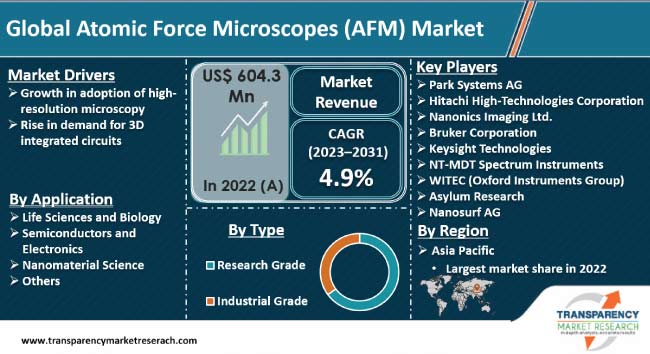
The global atomic force microscopes (AFM) market was valued at around US$ 471.9 Mn in 2017 and is anticipated to register a stable CAGR of over 4.5% during the forecast period 2018 to 2026, according to a new report published by Transparency Market Research (TMR) titled “Atomic Force Microscopes (AFM) Market– Global Industry Analysis, Size, Share, Growth, Trends, and Forecast, 2018–2026.” Growing need for high resolution microscopy and rising adoption of atomic force microscopy in biology and biomedicine has increased the penetration and growth of the atomic force microscopes (AFM) market globally. The market in North America is expanding at the highest CAGR of 5.7% on the backdrop of numerous technological innovations in advanced microscopy.

Request a Sample – https://www.transparencymarketresearch.com/sample/sample.php?flag=S&rep_id=4746
Growing Need for High Resolution Microscopy to Drive Market Growth
The growing necessity for high resolution microscopy offering high scanning quality and great degree of accuracy has increased the demand for atomic force microscopes globally. High resolution microscopes are necessary to get three-dimensional surface profile of a sample. Various nanotechnology providers across the world are deploying advanced microscopes in order to tackle a wide range of nano scale research demands. Numerous players from North America are continuously offering technologically advanced high resolution atomic force microscopy solutions for accurate measurements. In February 2017, Canada based Integrated Circuit Scanning Probe Instruments (ICSPI), a provider of scanning probe instruments, developed the highest resolution single-chip atomic force microscope (AFM) for different fields of science and technology. Key trends prevalent in the atomic force microscopes (AFM) market are AFM for drug development, single chip AFM, improved probe technology, technological advancements, and strategic collaboration.
Life Sciences and Biology Segment to Dominate the Global Atomic Force Microscopes (AFM) Market
The application segment is divided into smartphones, life sciences and biology, semiconductors and electronics, nanomaterial science and others. Life sciences and biology segment is anticipated to dominate the market owing to growing adoption of atomic force microscopes in the biology sector due to the benefits that AFM brings to biology such as determining high-resolution structure, examining mechanical properties, and determining force interactions, all at the nanometer scale. Researchers are increasingly using AFM for ultra-high-resolution studies of proteins and DNA. These factors are expected to boost the growth of the atomic force microscopes (AFM) market. Life sciences and biology segment is anticipated to expand at the highest CAGR of 5.2% during the forecast period 2018 to 2026.Semiconductors and electronics segment is projected to expand at a significant CAGR over the forecast period owing to the growing popularity of smartphones and other electronic devices.
Growing adoption of Atomic Force Microscopes (AFM) due to technological advancements and growth in the biological industry in China, India, South Africa, Brazil, and Taiwan to create more opportunities in the market
Geographically, the global atomic force microscopes (AFM) market is divided into five major geographical regions. These include North America, Europe, Asia Pacific, South America, and Middle East & Africa. In 2017, North America was the topmost revenue generating region followed by Asia Pacific. Nanotechnology providers from North America are continuously taking efforts to introduce advanced technologies such as high resolution, single chip AFM and enhanced probe technology systems in order to achieve better productivity and accurate Nano scale measurements. The U.S. held the highest market share in 2017 in North America and is estimated to expand at a considerable CAGR during the forecast period.





